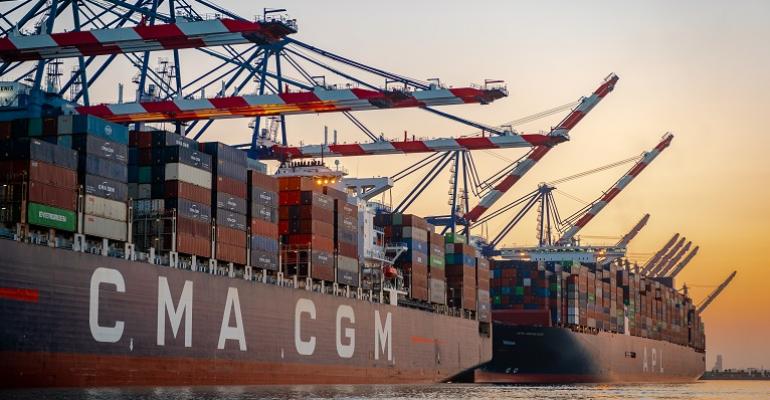Container lines in US regulators' crosshairs
Container lines in US regulators' crosshairs
Photo: CMA CGM
In the year and a half since “supply chain disruption” entered the vocabulary of US citizens, whose only interactions with container shipping were seeing boxes on trucks speeding down the motorways, the sector has moved firmly into the political crosshairs.
Barry Parker | May 11, 2022
By early 2021, when vessels at anchorages - mainly at Los Angeles – Long Beach - began to appear in the news, the sleepy Federal Maritime Commission (FMC) was starting to gain attention, especially from US based cargo owners who were feeling the pains of congestion and delays, and firm pricing, notably from “blanked sailings” in 2020.
In early 2021, the FMC sought to act on the complaints that were being conveyed, often through legislators on Capitol
Hill, and sometimes in direct communication from cargo interests. Last year, the FMC began a deep dive into data needed to better analyze what the carriers, and the big alliances, were doing. A year on, the FMC has stepped up its efforts to monitor carrier actions, as well as increase transparency for the cargo side.
In early May 2022, the FMC announced that the “big three” global ocean carrier alliances 2M, Ocean Alliance, and The Alliance - and each of their member companies will now be required to provide enhanced pricing and capacity information, providing the FMC with data, in a uniform format, to be used by the Commission in “assessing ocean carrier behavior and marketplace competitiveness.” According to the FMC, the newly mandated information will provide its Bureau of Trade Analysis (BTA) “… with insight into pricing of individual trade lanes and by container and service type. It will also provide more immediate information regarding capacity management decisions of ocean carriers and alliances.”
Also in the works are proposals for regulations, which would be codified in its rules, going beyond “mandates” to provide information, which have been in the works for over a year -starting with an Advanced Notice of Proposed Rulemaking in April 2021. The proposed regulations, published in the Federal Register at the end of April,2022- opening up a month comment period, would amend the wording of Federal regulations (in 46 CFR, section 520) covering liner shipping. The proposed changes would impact questions of whether carrier tariffs should be available free of charge (not always the case) and if the definition of “co-loading” should be changed to apply only to less than container loads.
The FMC explains: “The proposed change to tariff publication rules would require ocean carriers to post their tariffs free of charge on their websites. Seven of the ten leading ocean carriers serving the United States already provide this service and the Commission believes that requiring universal free tariff publication would benefit the trade by providing more information to shippers on pricing when considering service options.”
Prior to reforms in the late 1990s, tariffs were published by the FMC, but reform legislation gave carriers the option of charging for access. The FMC noted that advances in digital technology have simplified publication of tariffs, and that a whole host of “pass through” type charges can be posted quickly.
Regarding “co-loading” the proposed changes are all about transparency. Non Vessel Owning Common Carriers’ (NVOCC’s) transactions among themselves, where one intermediary might shift cargo to a container booked by another, has led to a lack of visibility for cargo owners, in the FMCs view. The provisions proposed here (really a re-wording of the existing regulations) would benefit cargo owners- who were sometimes unaware of which NVOCC was controlling the movement of their cargo- when combined with other shippers’ goods in containers.
The FMC says: “The Commission is proposing changing its regulations to change the definition of co-loading to apply only to less than container loads. The change is intended to align Commission regulations with current industry practices. The Commission is also proposing that documentation accompanying full container load shipments be annotated with the names of all non-vessel operating common carriers (NVOCCs) associated with the cargo the container is carrying.”
At a very high level, the carriers have a high market concentration and therefore a powerful position negotiating rates and managing their capacity; however, US based cargo interests are far better organised for speaking out. Also, through no fault of the carriers, existing rules have not kept up with industry practices.
Earlier this year, the law firm Holland & Knight, which has a leading Washington DC maritime presence, wrote: “the maritime industry can well expect its practices to undergo increased scrutiny for both criminal and civil violations. Accordingly, it is an opportune time for shipping companies and other industry participants proactively to take a fresh look at their existing compliance policies to determine whether they are effective or whether modifications are warranted.”
The latest proposed rules are here: https://www2.fmc.gov/readingroom/docs/21-03/21-03_2022-04-19_520_NPRM.pdf/